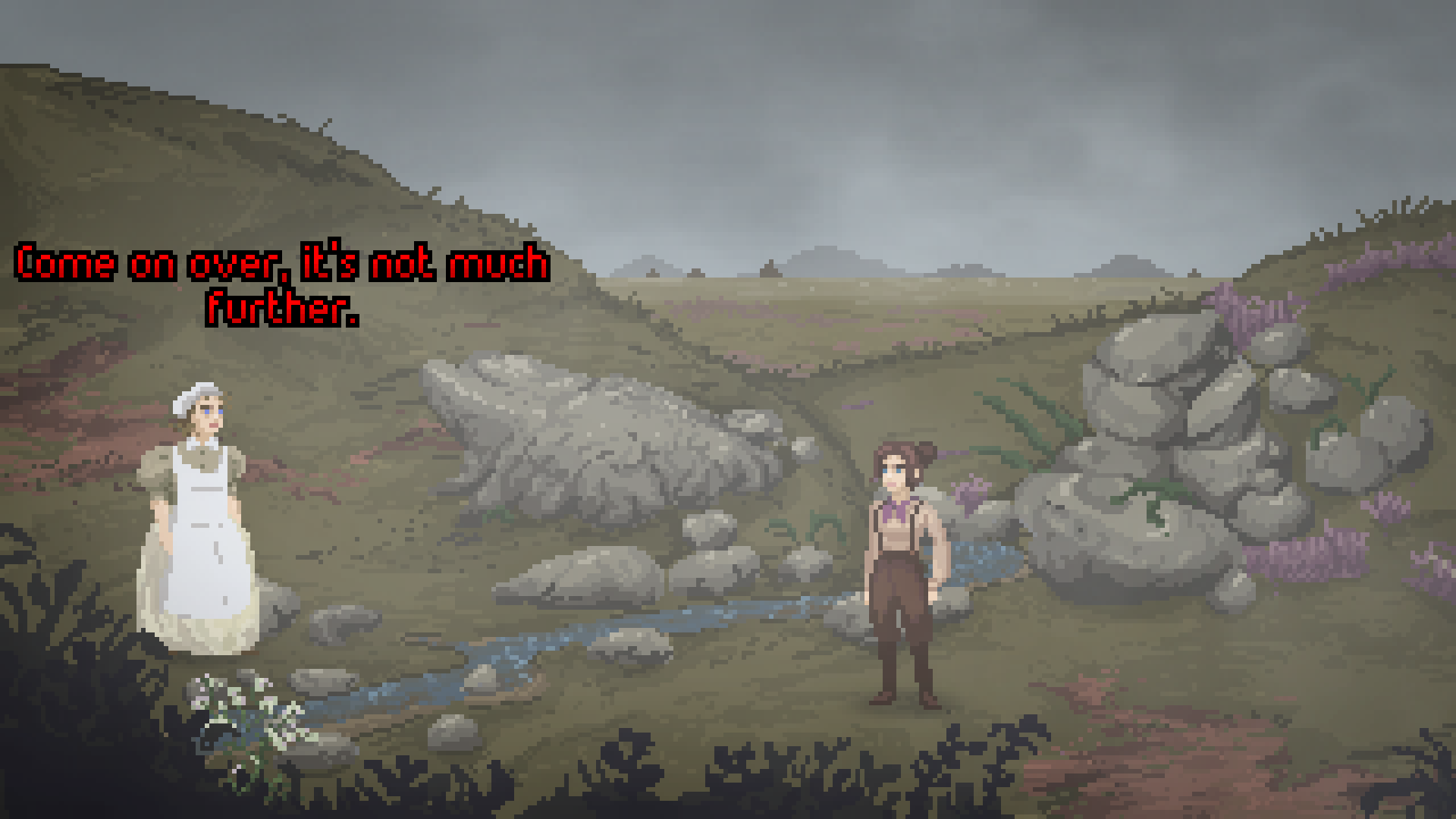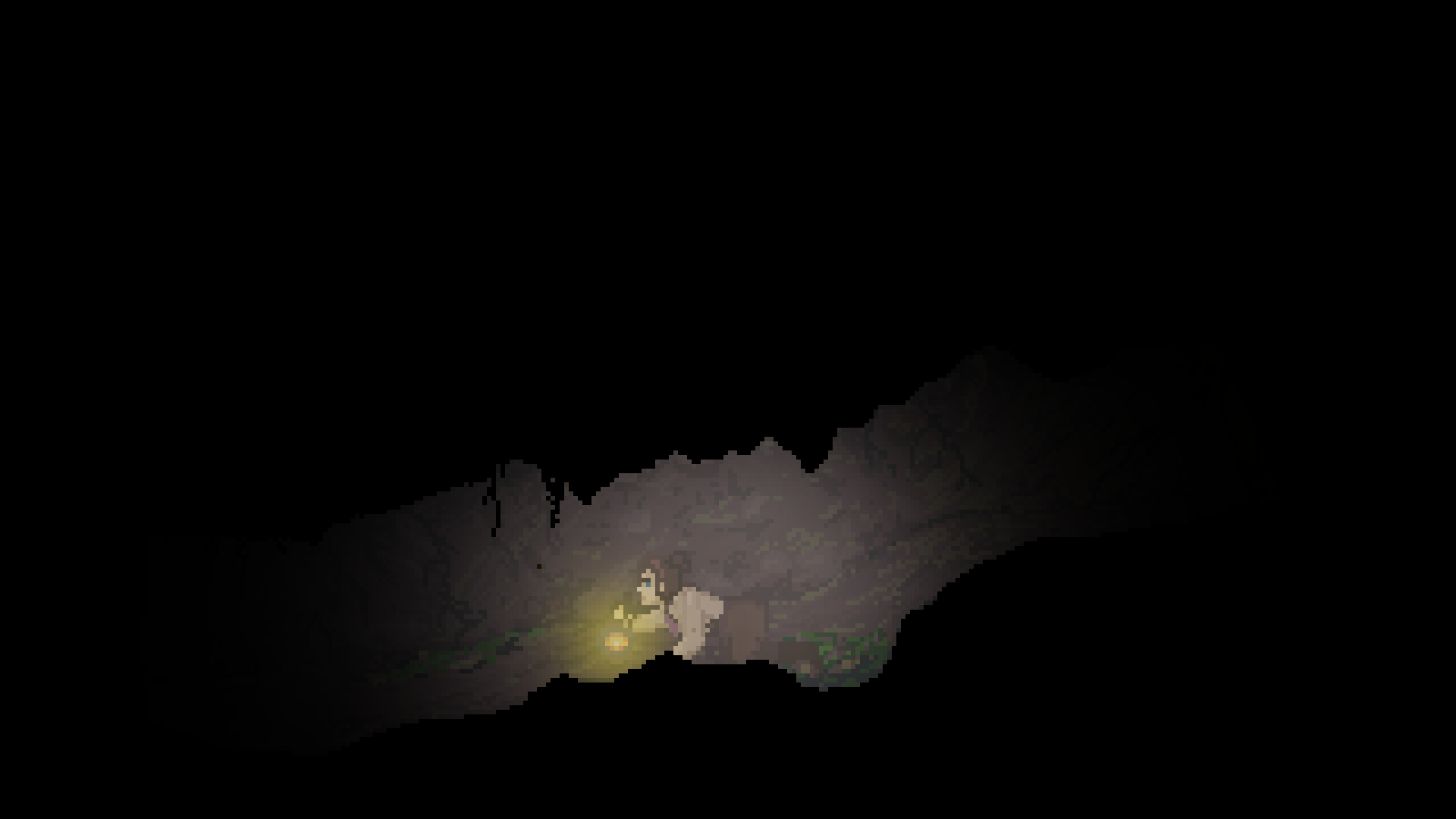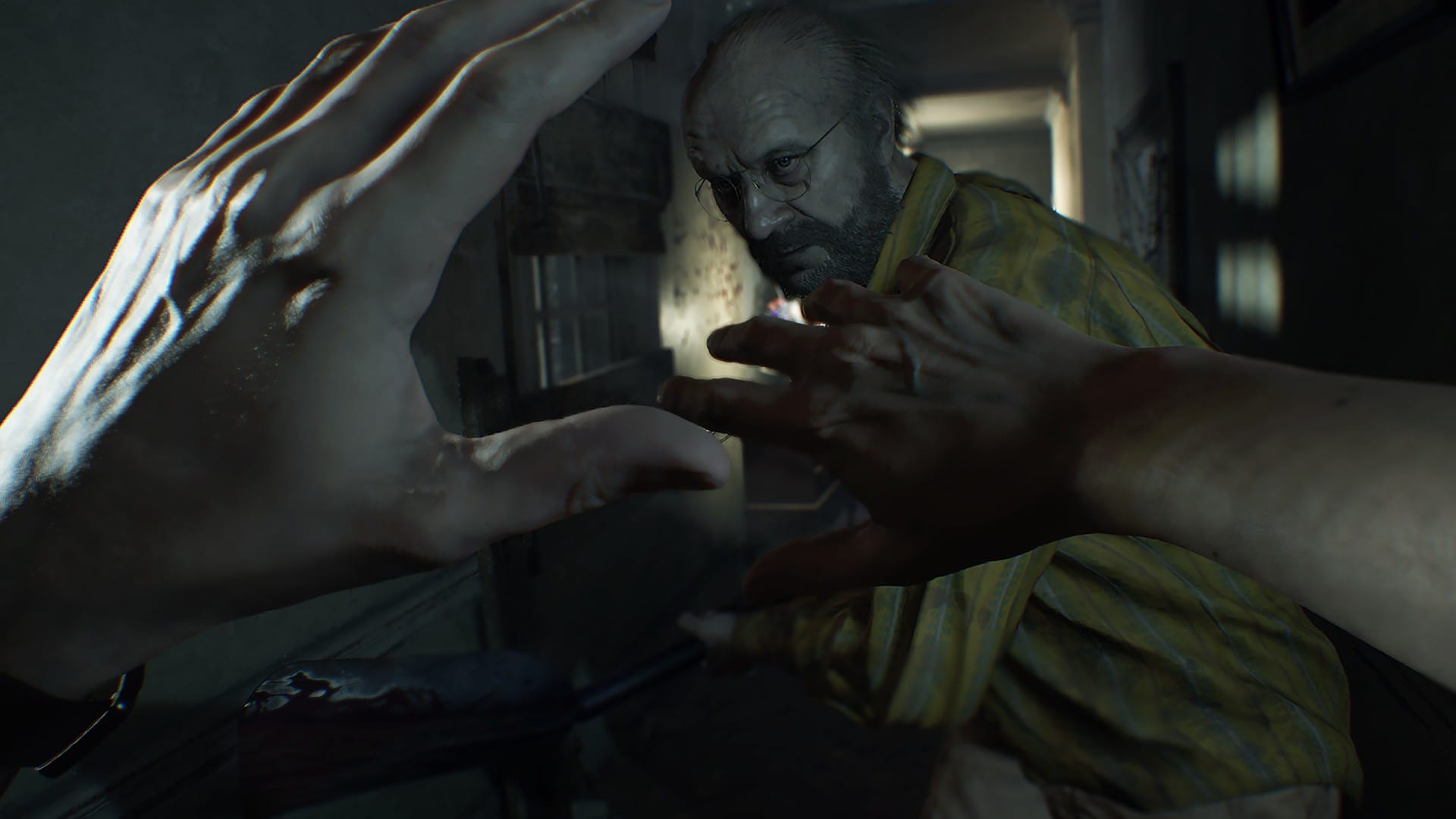Framing the Depths: An Archaeological Approach to Cinematography in The Excavation of Hob’s Barrow
Exploring horror through cinematographic techniques

The Excavation of Hob's Barrow is a folk-horror narrative-driven point-and-click adventure game where players experience horror through its story and through a cinematic blend of film techniques that sets it apart from traditional horror games. You play as Antiquarian Thomasina Bateman, a female researcher and writer studying the barrows of England (ancient burial mounds found across the UK). Thomasina is invited to the rural town of Bewlay. Once she arrives, she is unwelcome, and the townspeople act strangely, chiefly concerning their religious practices and the local ancient burial mound, Hob's Barrow. Once Thomasina Bateman overcomes the initial disdain of the town, she is only drawn deeper into the mysteries of Bewlay, its people, and the ancient Barrow. The narrative escalates from this point, and Thomasina is drawn deeper and deeper into the unknown.
With introductions aside, I'll leave this piece spoiler-free because this is not a discovery of The Excavation of Hob's Barrow's story, music, graphics, UI, or other concrete elements. This article is unearthing highlights from the indie title The Excavation of Hob's Barrow, which successfully tests the boundaries of what is recognizable as horror game symbology by borrowing and implementing specific camera points of view from the film industry. So, bear in mind that this is not only a positive review but a wildly positive one. I do not need to repeat the gushings already made about this game by countless other reviewers. It is clear that The Excvacation of Hob's Barrow is profound; the work poured into making this game is evident, and you should play it–now!


The Excavation of Hob's Barrow does some of Horror's atypical cornerstoning. For example, it provides jump scares and moments where the player feels the empathetic tension in the nerve-wracking driver's seat while rooting for the protagonist. The list of films (and games!) with jump scares is endless. Think of those abrupt moments in Jaws or when Samara suddenly crawls out of a TV screen in The Ring. Jump scares are everywhere and are implemented to a fault. Some criticize jump scares as cheap, easy, and overused, as it is the most straightforward way to elicit a reaction. However, jump scares are a standard tool in Horror. When used sparingly in combination with other techniques, jump scares can create extraordinary moments of building and releasing tension for the viewer.
However, The Excavation of Hob's Barrow also employs other horror tropes that deserve a more pronounced observation. I'll refer to these as the tracking shot and the "gross-up". By focusing our attention on these additional visual cues, The Excavation of Hob's Barrow does something distinguishable as a video game in its engagement with the symbolic discourse of horror games and movies alike. So, instead of tapping into our fight or flight instinct alone, The Excavation of Hob's Barrow leaves us worried at every save point. Instead of being a series of jump scares and threats, Hob's Barrow is like goosebumps on the arm in an "I've got a bad feeling about this" sort of place. What this game lacks in action-packed fear, it cleverly makes up for by utilizing cinematic shots borrowed from TV and movies. The Excavation of Hob's Barrow not only succeeds as a horror game but also successfully borrows the signature shots of horror filmmaking to elevate the game further.
Source: YouTube.
It starts with the side scrolling perspective. The game's point of view is imbued with what feels like a tracking shot. A moving shot in film fixed on a character's action. This film technique gives the sense of continuous motion, much like the side scrolling perspective in games. For our purposes, this perspective heightens the tension by limiting our view. It dramatically limits the player's visibility, controls the pace and space for progression, and adds emphasis on environmental storytelling, both seen and unseen. The screen is saturated with anticipation as the world unfurls before the player. The edge of the screen calls to us. What's beyond this building? What happens if I go a little further? Why can't I open this gate? Uh, wait a second– why can't I go back the way I came?
From this perspective, the player feels entirely vulnerable as they take each step toward the edge. A movement into the offscreen is a player also moving toward the unknown. So, not only is there captivating storytelling onscreen, but also there is all that happens off-screen. The unknown place is that all-shared dark space of Horror that compels us forward through horrifying narratives. The unknown, where there is nothing more frightening than our imaginations– and successful Horror must, above all else, employ our imaginations against us!
As William F Nolan famously put it:
"Nothing is so frightening as what's behind the closed door. You approach the door in the old, deserted house, and you hear something scratching at it. The audience holds its breath along with the protagonist as she/he (more often she) approaches that door. The protagonist throws it open, and there is a ten-foot-tall bug. The audience screams, but this particular scream has an oddly relieved sound to it. 'A bug ten feet tall is pretty horrible,' the audience thinks, 'but I can deal with a ten-foot-tall bug. I was afraid it might be a hundred feet tall.'"

The screen is saturated with anticipation as the world unfurls before the player. The edge of the screen calls to us. What's beyond this building? What happens if I go a little further? Why can't I open this gate? Uh, wait a second– why can't I go back the way I came?
This is where the fear behind a hollow jump scare disintegrates before the viewer's gaze. No longer obscured, the truth is revealed, and even the most horrific sights leave us dissatisfied. That's why the over-implementation of the scare tactic can feel cheap. The Excavation of Hob's Barrow's success largely relies on its use of a forced perspective to shape the player's experience instead of focusing on a series of jump scares.
The tracking shot and any point of view that forces perspective are perfect for horror games in general. Look at the beloved Resident Evil series. The series' camera framing has changed with time from a forced third-person perspective to its recent change to a first-person point of view. The player may move more freely in some regards, but it is still a limited vision and field of view. You cannot have eyes in the back of your head, and the most recent instalments recognize that scope.

In one facet, forced perspective limits the player's view to an almost claustrophobic-like space. It has the essence of being trapped. You can only see so much behind you, in front, above, and below, unlike racing, flying, shooters, or other genres that allow you to move the camera more freely in a more complex space. In Hobs' Barrow, for example, you're very much attached to a linear path where you know, in your gut, something 'bout to happen. But there's nothing you can do about it. Therein lies the beauty of Horror! The fatalistic revelation in the viewer that something terrible is going to happen, but pressing on anyway! The Excavation of Hob's Barrow truly captures this essence with its chosen point of view and perspective.
When Hob's Barrow isn't tracking our (protagonist), it is presenting the story to us in a series of other cinematic views. It utilizes the classic establishing shots for setting scenes and the long-employed shot/reverses shot for dialogue. However, the most prominent shot in The Excavation of Hob's Barrow is what I'll refer to as the "gross-up." While building on the game's atmospheric tension, this technique serves as its most authentic visual representation of horror, taking the traditional close-up and shaping it into something deeply unsettling.
The gross-up is the glamorous film close-up of yesteryear turned septic. Instead of framing the soft-lit faces of stars like Audrey Hepburn or Anne Bancroft in a famous close-up shot, the gross-up is a close-up, so absurdly close that it highlights the imperfections of a subject, like staring at someone from nose length. Even on the most beautiful face, eventually, you will find the ugly and focus on it. This technique takes ugliness and imperfection to the furthest extreme.
The gross-up was made infamous by '90s cartoons like Ren and Stimpy, SpongeBob Square Pants, and Courage the Cowardly Dog. It is even noticeable in the horrific illustrations of notorious Japanese manga artist Junji Ito. Artists of the '90s and early 2000s were not only inspired by the outlandish body horror in the Looney Toons of Bob Clampett but also perhaps influenced by the grotesque horror shots and gross-out films of the previous decades. The gross-up is reminiscent of the cerebral yet monstrous films that catapulted David Lynch's career. We can also discern the origins of the gross-up in the anxious and ugly close-ups of Alfred Hitchcock and his filmography. In many ways, the gross-up is also a passing nod to the likes of John Waters and the lines of disgust that his films and other gross-out flicks of the '70s dared to cross.

However, the most prominent shot in The Excavation of Hob's Barrow is what I'll refer to as the "gross-up." While building on the game's atmospheric tension, this technique serves as its most authentic visual representation of horror, taking the traditional close-up and shaping it into something deeply unsettling.
In The Excavation of Hob's Barrow, the gross-up becomes an important indicator and punctuator to the story's beats. These gross-ups easily arouse our senses and highlight some of the game's most important moments. It leaves the player disgusted, worried, and intrigued, like the visceral and illegible innards used in haruspex. Somewhere in the entrails is a message, but we can't quite discern its meaning.
Like the jump scare, what makes these moments especially effective is their timing. The narrative direction knows when to pull back and when to push the players into this uncomfortable view. Much like the jump scare, it is often seen in moments where tension is already high. However, unlike the jump scare, which often reveals something, these views usually leave us reeling with more questions than answers: What is that? What's going on here? Why does it look like that? The nature of the gross-up is to disorient and, therefore, adds a layer to the already unsettling narrative. In many ways, the gross-up is also a reminder about what is central to horror. That is, horror, at its most rudimentary level, is about uncertainty and being faced with things we cannot fully understand but are forced to confront. Hob's Barrow masterfully employs this technique.
The Excavation of Hob's Barrow is a standout in the horror video game genre. Not only does it capture the nature of traditional horror, but it also innovates how we interpret horror in games by leaning heavily on cinematic techniques. The deliberate limitation of the player's view and the further tunnelling of the player's vision with gross-ups work in tandem to create an unsettling sense of dread and, more importantly, anticipation. The Excavation of Hob's Barrow is a Horror masterpiece that will resonate with fans of the genre for years to come.
The Excavation of Hob's Barrow is available on Steam for $14.99.
